|
Elegant and Ornate Antique Ceiling Tiles
by C. Dianne Zweig
Beautiful, ornate, antique tin ceiling tiles are very popular today and are
being used as decorative accessories, wall décor, supports for artwork and of
course, for home remodeling projects. These elegant and charming "collectibles"
are back in vogue and continue to attract many buyers.
Ceiling tins can be
found in original form or as newly manufactured products made to mimic the charm
and elegance of the older looks. There are several groups of people who are
eager to find tiles in their original form: collectors, homeowners and
artists/crafters.
First, let us begin with a little background about tin
ceiling tiles. Pressed or embossed tin ceilings were very popular during the
Victorian Era as an affordable substitute for the plaster-designed ceilings
found in wealthy European homes. Thin metal sheets of tin, copper or stainless
steel were stamped with intricate patterns and often painted white to resemble
the more expensively-produced, hand-carved or molded plaster ceilings. Companies
in Ohio, New York and Pennsylvania mass produced thin metal plate during the
late 1800s and created numerous patterns from which buyers could
choose.
During the WW II Era, tin ceiling tiles went out of favor as metals
were conserved for the war effort, and other types of ceilings were promoted. By
the 1950s and 1960s, acoustic drop ceiling tiles and dry wall dominated the
marketplace and could be found in homes, hotels and buildings.
Because
original tin ceiling tiles have such pretty designs and craftsmanship, many
people like to collect these lovely antique pieces. Collectors enjoy finding
tiles of different sizes, as well as seeking out tiles with unique patterns,
shapes, colors and symbols.
On eBay, these tiles are categorized under the
heading "Architectural & Garden" in the antique category. Searching the
words antique ceiling tins will bring you into the section where you will find
early tin ceiling tiles. Using the phrase vintage ceiling tile generally calls
up a list of "vintage style" or "reproduced" tiles. Prices vary according to the
size, quantity and uniqueness of design. For collectible older tiles, prices
vary according to rarity, availability, intricacy of pattern and whether a
particular tile has been reproduced You can expect to find small ordinary tiles
for as little as $5 and fancier larger tiles or groups of tiles from $25 and up.
With so many reproduced tiles available it may get a little tricky to tell
the vintage pieces from the newer models. Older ceiling tin is heavier than the
newer version and has surfaces showing lots of rust, dents, chippy paint, rough
scaly edges and sharp nail holes.
Although reproductions are made to look
like the real thing, you will notice that the new items are lighter and smoother
and are simply too perfect. Also worth mentioning is that sometimes old tiles
appear new when they are not. This can happen when a vintage piece is cleaned
and refinished or an original tile is framed with an old door or window trim.
Unlike older tiles which rust, newer tiles are often made with a special
powder finish which is rust-proof, allowing for indoor and outdoor use. But even
"cleaned up" older tiles look and feel differently than new ones. Collectors who
handle lots of these detailed works of art learn to distinguish the
differences.
While true collectors mix and match their collections with
different examples of tiles, homeowners who may want to remodel a kitchen
ceiling or frame a fireplace need to find multiple tiles. They generally look
toward new versions of these handsome decorative items.
Reproduced tiles are
made from a variety of materials such as tin, vinyl, wood and plastics, and they
come in numerous colors and finishes. Popular colors for store-bought tin tiles
are copper, bronze, gold, black, silver, rust, burgundy, mocha and whites or
unpainted for custom colors. The American Tin Ceiling Company
(www.americantinceilings.com), a large provider of reproduced ceiling tiles,
carries 70 colors and 33 patterns of ceiling tiles to choose from. Sales manager
Ken Lindfors has had great success with a newer product called Snap-lock ceiling
tiles. These tiles can be screwed into any ceiling (drop, popcorn, etc.). You
can order sample tiles to evaluate before you begin a project.
While the
Snap-lock variety of ceiling tile is very popular, there are other innovative
applications of ceiling tiles on the market today. For example, you can now
purchase tiles that come in rolls like wallpaper. Architectural Inspirations
(Norwall Group, Inc., www.norwall.net) makes a paintable vinyl, pre-pasted
wallpaper ceiling tile. Other companies sell peel-and-stick types of ceiling
tiles.
Besides using tiles for the ceiling, homeowners often add tile as a
kitchen backsplash or a medallion for hanging fixtures. Some creative folks even
use ceiling tiles as faux headboards. Another group of individuals who look for
vintage tiles is artists and crafters. These talented folks make handsome objets
d'art out of these architectural salvaged masterpieces.
Ruth Welter of
www.artfulcreations.biz
likes to paint on vintage ceiling tiles. She looks for
tins that are more than 100 years old, in good shape and requiring minimal prep
work. Ruth generally passes up tiles that have holes or dents, but she is
interested in unusual designs or shapes which inspire her to use the background
as part of her subject matter and design work.
Rhonda Juniper and her
husband Jack E. Ray (www.antiquecottagerose.com) have had great success selling
frames made out of old tiles and inserting a canvas with Rhonda's florals and
other images.
While many current artists are discovering a variety of ways to
use old ceiling tins and other salvage materials, the Pennsylvania Dutch have
crafted objects from tin for a very long time. For example, they are noted for
creating barn stars out of old tin roof material. Many stores specializing in
country gifts sell reproduction stars.
Interest in architectural salvage
continues to grow as collectors, homeowners and artists are falling in love with
old world craftsmanship. Using reclaimed ceiling tin as decorative accessories
in today's homes is an excellent way to blend older traditions with modern day
lifestyles.
C. Dianne Zweig (www.cdiannezweig.com) is the author
of the newly-released book Hot Cottage Collectibles for Vintage Style Homes and
also Hot Kitchen and Home Collectibles of the 30s, 40s, 50s. Zweig's retro and
cottage collections can be found at her shop Kitsch-n-Stuff at The Collinsville
Antiques Company of New Harford, Ct., a 22,000-square foot antique emporium.
|
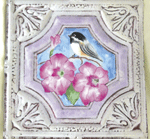
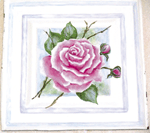
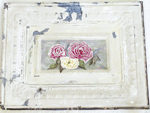
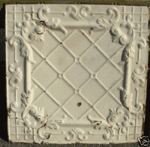
Vintage 24 x 24 inch ceiling tin, grill pattern.
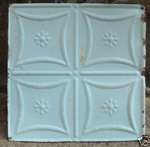
6-inch pattern ceiling tin. (Photos this page, courtesy eBay seller Vinmondi,
eBay store Easy Street Artifacts.)
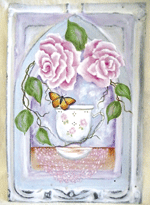
"Tea & Roses Vintage Gothic Ceiling Tin" by Ruth Welter, 13-3/4 x 9-1/2
inches. |